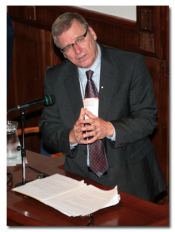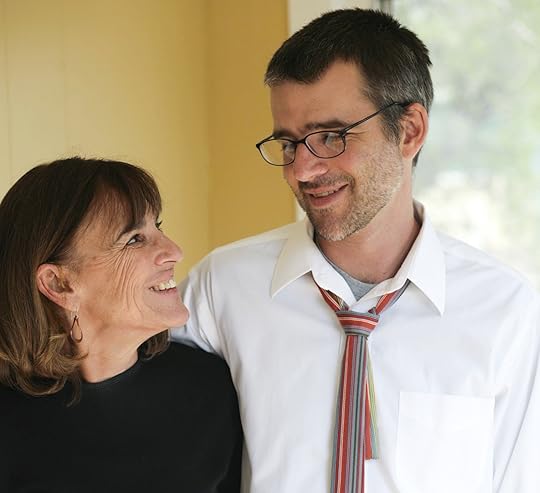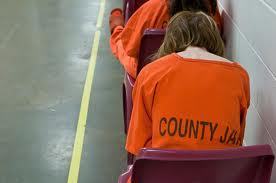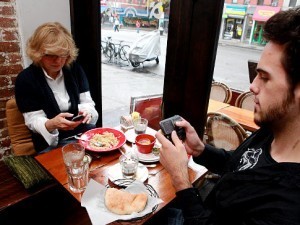Kathy Brandt's Blog, page 4
April 28, 2013
Pete Earley: A Voice for National Alliance on Mental Illness (NAMI)
I am so grateful to Pete Earley for speaking out about mental health issues. Pete is a vocal advocate for NAMI (National Alliance on Mental Illness) and for those with mental health and their families. For him, like so many of us, his advocacy began when his son was diagnosed with bipolar disorder. Suddenly, he says, he and his son “were thrown headlong into the maze of contradictions, disparities and Catch-22s that make up America’s mental health system.”

Pete Earley
As a journalist and bestselling author, it was inevitable that he would write about the issues of mental health. His book, CRAZY: A Father’s Search Through America’s Mental Health Madness, a finalist for the Pulitzer Prize, tells of the criminalization of mental illness in our country. He writes in detail about the circumstances of the mentally ill in our jails and prisons and about the injustice of a system in which those with mental illness end up being punished for their illnesses rather than being treated.
Pete is passionate about the issues. His accomplishments as an advocate for those with mental illness are a testament to what each of us can achieve as individual voices in the fight for better treatment for those with mental illness.
Thank you, Pete!
See Pete’s blogs about Max and me and excerpts from Walks on the Margins: “I Don’t Die At The Hand Of A Stranger, Especially If That Stranger Is Me” and “The Heart of NAMI: A Mom Explains”
Pete Earley: Advocate for Mental Health
I am so grateful to Pete Earley for speaking out about mental health issues. Pete is a vocal advocate for NAMI (National Alliance on Mental Illness) and for those with mental health and their families. For him, like so many of us, his advocacy began when his son was diagnosed with bipolar disorder. Suddenly, he says, he and his son “were thrown headlong into the maze of contradictions, disparities and Catch-22s that make up America’s mental health system.”

Pete Earley
As a journalist and bestselling author, it was inevitable that he would write about the issues of mental health. His book, CRAZY: A Father’s Search Through America’s Mental Health Madness, a finalist for the Pulitzer Prize, tells of the criminalization of mental illness in our country. He writes in detail about the circumstances of the mentally ill in our jails and prisons and about the injustice of a system in which those with mental illness end up being punished for their illnesses rather than being treated.
Pete is passionate about the issues. His accomplishments as an advocate for those with mental illness are a testament to what each of us can achieve as individual voices in the fight for better treatment for those with mental illness.
Thank you, Pete!
See Pete’s blogs about Max and me and excerpts from Walks on the Margins: “I Don’t Die At The Hand Of A Stranger, Especially If That Stranger Is Me” and “The Heart of NAMI: A Mom Explains”
April 18, 2013
Walk with the National Alliance on Mental Illness (NAMI) — Walk for Mental Health
 Walk with the National Alliance on Mental Illness (NAMI) during May Mental Awareness Month and “Change Minds One Step at a Time.” Founded by parents of children with mental illness, NAMI is the largest grassroots mental health organization in the country. Its mission: to educate, support, and advocate for those with mental illness and their families, to tell entire communities about what it means to struggle
Walk with the National Alliance on Mental Illness (NAMI) during May Mental Awareness Month and “Change Minds One Step at a Time.” Founded by parents of children with mental illness, NAMI is the largest grassroots mental health organization in the country. Its mission: to educate, support, and advocate for those with mental illness and their families, to tell entire communities about what it means to struggle with mental illness and that recovery is possible. One in four adults is affected by mental illness and NAMI is dedicated to raising awareness, fighting for services, advocating for better health care treatment, and for research.
with mental illness and that recovery is possible. One in four adults is affected by mental illness and NAMI is dedicated to raising awareness, fighting for services, advocating for better health care treatment, and for research.
When I think of NAMI, I think of the faces behind the logo, the people I have worked beside in our local NAMI affiliate in Colorado Spring to offer classes to those with mental illness, to their families, and to health care professionals; to raise awareness in the community, offering workshops in schools, in the workplace, and to other non-profits; to answer calls and help those in crisis. Hundreds of volunteers in our chapter teach classes, facilitate support groups, write for the newsletter, man the office, serve on the board, and much more. NAMI gives hope and support. When those who struggle with mental illness find NAMI, they find that they aren’t as alone as they once thought.
Walk with NAMI in your community. To find a Walk near you go to: http://www.namiwalks.org/
Walk with NAMI — Walk for Mental Health
 Walk with NAMI during May Mental Awareness Month and “Change Minds One Step at a Time.” Founded by parents of children with mental illness, NAMI is the largest grassroots mental health organization in the country. Its mission: to educate, support, and advocate for those with mental illness and their families, to tell entire communities about what it means to struggle
Walk with NAMI during May Mental Awareness Month and “Change Minds One Step at a Time.” Founded by parents of children with mental illness, NAMI is the largest grassroots mental health organization in the country. Its mission: to educate, support, and advocate for those with mental illness and their families, to tell entire communities about what it means to struggle with mental illness and that recovery is possible. One in four adults is affected by mental illness and NAMI is dedicated to raising awareness, fighting for services, advocating for better health care treatment, and for research.
with mental illness and that recovery is possible. One in four adults is affected by mental illness and NAMI is dedicated to raising awareness, fighting for services, advocating for better health care treatment, and for research.
When I think of NAMI, I think of the faces behind the logo, the people I have worked beside in our local NAMI affiliate in Colorado Spring to offer classes to those with mental illness, to their families, and to health care professionals; to raise awareness in the community, offering workshops in schools, in the workplace, and to other non-profits; to answer calls and help those in crisis. Hundreds of volunteers in our chapter teach classes, facilitate support groups, write for the newsletter, man the office, serve on the board, and much more. NAMI gives hope and support. When those who struggle with mental illness find NAMI, they find that they aren’t as alone as they once thought.
Walk with NAMI in your community. To find a Walk near you go to: http://www.namiwalks.org/
April 9, 2013
Bipolar Disorder: Telling Our Story
In 1999, my son, Max, was diagnosed with bipolar disorder. He was twenty and a junior at Grinnell College. I was shocked at the diagnosis, clueless about what it meant, and I was scared. What would the future hold for Max? We spent years trying to find good treatment in a mental health  care system that too often fails those who struggle with mental illness. I was angry that we couldn’t find the help Max needed. Finally I found support through NAMI (National Alliance on Mental Illness) and became an advocate for those with mental illness and their families. As a writer, my advocacy inevitably involved writing about the issues. And I wanted to tell Max’s story so that people would understand the difficulties of having mental illness and that recovery is possible. But I wouldn’t do it without Max. Though reliving the years of illness would be painful, Max agreed to write the book with me. The result is a memoir about our joint and separate struggles with bipolar disorder titled, Walks on the Margins: A Story of Bipolar Illness.
care system that too often fails those who struggle with mental illness. I was angry that we couldn’t find the help Max needed. Finally I found support through NAMI (National Alliance on Mental Illness) and became an advocate for those with mental illness and their families. As a writer, my advocacy inevitably involved writing about the issues. And I wanted to tell Max’s story so that people would understand the difficulties of having mental illness and that recovery is possible. But I wouldn’t do it without Max. Though reliving the years of illness would be painful, Max agreed to write the book with me. The result is a memoir about our joint and separate struggles with bipolar disorder titled, Walks on the Margins: A Story of Bipolar Illness.
Pete Earley, bestselling author of CRAZY: A Father’s Search Through America’s Mental Health Madness, was among the first to read our book. I met Pete when we worked together on an event for NAMI. He is a former Washington Post journalist whose son also has bipolar disorder. He kindly wrote about the book:
“Novelist Kathy Brandt and her son, Max, take readers on a terrifying journey through our nation’s broken, overwhelmed, underfunded, and frustrating mental health care system. Walks on the Margins will make you angry. It will make you cry. It will also inspire you! Ultimately, it is testament to the unconditional love of a parent and a son’s determination to overcome a serious mental illness. Writing in tandem, they have not only told their personal story, but have told the story of thousands of other American families who are everyday heroes — and they have told it extremely well.”
Writing Walks on the Margins brought Max and me together in ways I never imagined and it helped us make sense out of the years of chaos. We have succeeded in telling an honest, though often painful, story that ends with our understanding that mental illness is for life, but that redemption and recovery are possible. We hope that others with mental illness and their families will find comfort in the book and will realize they aren’t as alone as they might think. We also hope that we have helped to break down the stigma of mental illness and have made human and understandable an illness that so many fear.
March 28, 2013
In Prison with Schizophrenia
Last year I visited a man at the Colorado State Penitentiary, a Level V security correctional institution for adult males who are the most violent, dangerous, and disruptive offenders. His family, who lives in Kentucky, contacted me through my work at the National Alliance on Mental Illness (NAMI) and asked me to go. His mother, whom he usually called every week, had not heard from him in months and she was frantic.
David has schizophrenia, and during a psychotic episode he jumped on a bus headed for who knows where. When the bus stopped at a truck stop, he went inside, picked up a Buddha from the gift shop, and walked out the door. Buddhism was an important part of David’s life, even more so when he was delusional. Unfortunately, that Buddha was valued at over $1000—a felony. He was sentenced to a year that expanded to four because of his behavior in prison. Untreated and psychotic, he was in and out of solitary confinement, once for throwing a cafeteria tray at a guard. David’s family had been trying to get him transferred from the prison to the state hospital for over a year. They had no idea what his physical or mental state was but feared the worst.
After a month, I succeed in getting on his visitor’s list and headed to the penitentiary to see him. I was sitting in a booth separated by Plexiglas when a guard brought him in. He wore an orange jumpsuit, handcuffed, feet chained, his eyes wild and afraid. His anxiety kept him from sitting. Again and again from the other side of the glass, I reassured him that I was a friend; I was there for his mom; she was worried because he hadn’t called. He was so silent I wondered if he could speak at all. Trust came slowly but soon he settled into the chair and began to babble, too fast for me to keep up. He was disoriented, scared, and clearly psychotic, but he understood one thing—he wanted out. He pleaded with me to get him into the hospital even as I was walking out the door, my visiting time expired.
There was so little I could do. I hadn’t even been allowed to bring him snacks or cards from his family. The injustice was so apparent, the real crime not David’s, but the judicial and mental health care system that fails some of our most vulnerable. Instead of treatment, David was being punished. It’s such a common occurrence that those with mental illness comprise 25-30 percent of our prison population. In fact our county sheriff calls his jail the local mental health institution. Not only is the system unjust, it’s also costly, socially and economically. If David were in treatment, we, as taxpayers, would not be footing the expense of his incarceration, and David would have the chance to recover.
The good news is that two weeks after my visit, David was finally transferred to the forensic unit at the state hospital, which is reputed to be one of the better psychiatric hospitals in the state. The last time I spoke with the family, they reported that David had stabilized, was calling his mother again, and his fear was gone. I’d like to think it was because of my visit and my connection to NAMI. But whatever the reason, David was where he needed to be.
March 10, 2013
Sequester Threatens Those with Mental Illness & Their Families
Clearly, Americans are just plain tired or perhaps more accurately hopeless. We hardly blinked when Congress once again failed us, allowing sequestration to take effect, an act which just a year ago seemed catastrophic and impossible. By this February we knew what was up. Congress [image error]went on break and came back with barely a hint that it would act. To soften the blow, many argued that the effects of the cuts weren’t really going to be that bad, not as bad as President Obama predicted.
But as a mom and advocate for those with mental illness, I’m concerned about what sequestration means for those with mental illness and their families. Just last week, I blogged about the vital need for improved mental health care in light of the Newtown and Aurora shootings. And the outcry has been loud from others – our legislators, our health care professional. But how can we expect improvements in mental health care treatment when programs, underfunded for decades, will be cut even further?
Under the sequester, 373,000 children and adults with serious mental illness will lose services that help prevent hospitalization, homelessness, and incarceration. In addition, estimates indicate that 200,000 Americans will lose access to substance-abuse treatment and 8,900 mentally ill homeless people will be cut off from outreach programs that provide shelter and treatment.
It piles insult onto injury. Over the past three years, state mental health budgets have been cut by a combined $4 billion. That in spite of the fact that one in every four Americans lives with a mental health condition and some 70-80% of adults and children do not receive treatment.
Whatever happened to our belief that as citizens we must care for the most vulnerable among us? It’s not just a failing for those who need help, it’s a failing for all of us. It affects our quality of life, our community environments, and our pocketbooks as we pay for homelessness, increased prison populations, and the pressure on emergency rooms.
How can we be so shortsighted? Further cuts will be devastating to communities and to those living with mental illness. They threaten the lives of hundreds of thousands of children and families.
March 5, 2013
Why Does a Newtown or Aurora Happen?
With the recent discussion about mental illness that has surrounding the tragedies in Newtown and Aurora, it’s important for people to understand that those who suffer from mental illness are more likely to be victims of violence than perpetrators of it. Too often the mentally ill are perceived as violent. They are feared, stigmatized, and discriminated against. They are avoided, shunned, and are unable find employment. They become isolated and self-esteem plummets. But even worse, this marginalization affects the availability of treatment. If Adam Lanza or James Holmes had had access to care these shootings would not have occurred (The fact that lethal weapons were readily at hand certainly made things worse.)
But I feel encouraged by some of the discussion taking place about our mental health care system, one that is clearly broken. When mental institutions were closed back in the 60s there was agreement that comprehensive community mental health care services would be developed. That never happened because funding was never set aside for that purpose. As a result our emergency rooms, the criminal justice system, and families are left to shoulder the burden when people are in crisis.
It’s difficult if not impossible for families to find help for their loved ones. Unless a person is considered dangerous to themselves or others, the system simply does not respond. As a result prisons have become our de facto psychiatric hospitals. The mentally ill fill our jails and account for a high percentage of our homeless population. And sometimes an Aurora or Newtown occurs. Then we wonder how it could have happened. It’s a tragedy for all the victims. And let there be no doubt that the Adam Lanzas and James Holmes are among them.
Let’s hope that things will change as a result of these recent events. That our citizens will rise to the occasion and demand change and that government will support those changes. There is no cure for mental illness, but with treatment recovery is possible. Those with mental illness can and do live fulfilled lives as contributing members of their communities.
I welcome your comments.
August 23, 2012
Cell phones, i-phones, Blackberries Oh No!
There was a time when I wanted nothing to do with cell phones and the only thing I used my computer for was writing. How things have changed. I’m chained to my cell, email, and the internet. They are my links to the world, and if I forget my cell phone, it feels close to disastrous. Unlike Dorothy, who with a few taps of her ruby slippers, returned to that idyllic place of old-fashioned values after her surreal journey down the yellow-brick road, for most of us there is no return.
Take the groom who had his blackberry in his pocket as he promised “until death do us part.” There should have been an added marriage clause: “or put on hold [image error]while I take this call.” For some, a 9-5 jobs has morphed into 24/7 because a client or boss expects an answer now. Our kids are texting in the car, in school, at the dinner table. We are so connected to our phones, that we have disconnected from those most important to us–the sons and daughters, the mothers and fathers, the spouse, the friend who sit right beside us.
I’ve tried to form some kind of truce with my cell phone, leaving it behind when I go to the market, turning it off when I step into the bath. Mostly I’m unsuccessful because I’ve become addicted to checking my messages. But when I lose myself in writing I find respite. Or my character finds it for me. When Hannah Sampson moves to the Caribbean, her last symbolic gesture is to toss her cell in her trash compactor. On the way to the airport, she tells her homicide partner that “air travel is second on the list of things I hate, right after cell phones, which have held first place for a while now.”
I’m trying to learn from Hannah’s example. It’s a small step. I’m most successful when I simply pull the plug as Hannah did. I considering going to places where it’s hard to connect. Get on a sailboat; find a little retreat in the rainforest in Belize, roam the Serengeti. But going cold turkey is becoming difficult even in faraway places.
[image error]Last fall, my husband and I were walking with other Tibetans around Jokhang Temple, the holiest site in all of Tibet. Pilgrims from all over the country were there, spinning their prayer wheels and fingering their prayer beads. Even though I know people the world over now have cell phones , I was taken by surprise when an old woman, long braid hanging down her back, apron rich with Tibetan color, pulled one from her skirt pocket.
Still, I was confident that cells would not find their way underwater any time soon. I was sure that in the ocean, we could all escape the ringing of a phone and the World Wide Web. Alas, I was mistaken. I have just discovered that a cell phone system is available for divers. Now it’s possible to check the stock market or take a call from your boss while admiring a coral garden or watching a turtle glide through the water.
Still, I don’t want to give up my cell phone. Though I will never use it while I’m scuba diving, I want to stay connected to my kids when I’m away. And that woman in Tibet might very well have been talking to her granddaughter in China. So it doesn’t seem so bad that we don’t want to tap those ruby slipper and return to Kansas anymore.
Cell phones, i-phones, Blackberries Oh No!
There was a time when I wanted nothing to do with cell phones and the only thing I used my computer for was writing. How things have changed. I’m chained to my cell, email, and the internet. They are my links to the world, and if I forget my cell phone, it feels close to disastrous. Unlike Dorothy, who with a few taps of her ruby slippers, returned to that idyllic place of old-fashioned values after her surreal journey down the yellow-brick road, for most of us there is no return.
Take the groom who had his blackberry in his pocket as he promised “until death do us part.” There should have been an added  marriage clause: “or put on hold while I take this call.” For some, a 9-5 jobs has morphed into 24/7 because a client or boss expects an answer now. Our kids are texting in the car, in school, at the dinner table. We are so connected to our phones, that we have disconnected from those most important to us–the sons and daughters, the mothers and fathers, the spouse, the friend who sit right beside us.
marriage clause: “or put on hold while I take this call.” For some, a 9-5 jobs has morphed into 24/7 because a client or boss expects an answer now. Our kids are texting in the car, in school, at the dinner table. We are so connected to our phones, that we have disconnected from those most important to us–the sons and daughters, the mothers and fathers, the spouse, the friend who sit right beside us.
I’ve tried to form some kind of truce with my cell phone, leaving it behind when I go to the market, turning it off when I step into the bath. Mostly I’m unsuccessful because I’ve become addicted to checking my messages. But when I lose myself in writing I find respite. Or my character finds it for me. When Hannah Sampson moves to the Caribbean, her last symbolic gesture is to toss her cell in her trash compactor. On the way to the airport, she tells her homicide partner that “air travel is second on the list of things I hate, right after cell phones, which have held first place for a while now.”
I’m trying to learn from Hannah’s example. It’s a small step. I’m most successful when I simply pull the plug as Hannah did. I considering going to places where it’s hard to connect. Get on a sailboat; find a little retreat in the rainforest in Belize, roam the Serengeti. But going cold turkey is becoming difficult even in faraway places.
 Last fall, my husband and I were walking with other Tibetans around Jokhang Temple, the holiest site in all of Tibet. Pilgrims from all over the country were there, spinning their prayer wheels and fingering their prayer beads. Even though I know people the world over now have cell phones , I was taken by surprise when an old woman, long braid hanging down her back, apron rich with Tibetan color, pulled one from her skirt pocket.
Last fall, my husband and I were walking with other Tibetans around Jokhang Temple, the holiest site in all of Tibet. Pilgrims from all over the country were there, spinning their prayer wheels and fingering their prayer beads. Even though I know people the world over now have cell phones , I was taken by surprise when an old woman, long braid hanging down her back, apron rich with Tibetan color, pulled one from her skirt pocket.
Still, I was confident that cells would not find their way underwater any time soon. I was sure that in the ocean, we could all escape the ringing of a phone and the World Wide Web. Alas, I was mistaken. I have just discovered that a cell phone system is available for divers. Now it’s possible to check the stock market or take a call from your boss while admiring a coral garden or watching a turtle glide through the water.
Still, I don’t want to give up my cell phone. Though I will never use it while I’m scuba diving, I want to stay connected to my  kids when I’m away. And that woman in Tibet might very well have been talking to her granddaughter in China. So it doesn’t seem so bad that we don’t want to tap those ruby slipper and return to Kansas anymore.
kids when I’m away. And that woman in Tibet might very well have been talking to her granddaughter in China. So it doesn’t seem so bad that we don’t want to tap those ruby slipper and return to Kansas anymore.



